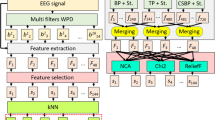Abstract
This study aims to extract the high-level features of driving fatigue using electroencephalography (EEG). The commonly used feature selection method is power spectral density (PSD) of five frequency bands, i.e., Alpha, Beta, Gamma, Delta and Theta band. This study proposes a new approach combined with ensemble empirical mode decomposition (EEMD) and PSD. EEMD provides several Internal Mode Function (IMF) components that can be used to extract PSD features. Multiple machine learning approaches, i.e., k-Nearest Neighbor (KNN), support vector machine (SVM), and hierarchical extreme learning machine algorithm with Particle Swarm Optimization (PSO-H-ELM), were used to evaluate the two feature selection methods. The results show that the accuracy based on EEMD’s PSD is obviously superior to feature extraction of frequency band’s energy spectrum. By comparing the accuracies, we came to the conclusion that the new feature selection method using the PSO-H-ELM classifier performed better with the highest average accuracy of 94.58%.
Access this chapter
Tax calculation will be finalised at checkout
Purchases are for personal use only
Similar content being viewed by others
References
Zhang, G., Yau, K.K.W., Zhang, X., Li, Y.: Traffic accidents involving fatigue driving and their extent of casualties. Accid. Anal. Prev. 87, 34–42 (2016)
Nilsson, T., Nelson, T.M., Carlson, D.: Development of fatigue symptoms during simulated driving. Accid. Anal. Prev. 29, 479–488 (1997)
Ting, P.-H., Hwang, J.-R., Doong, J.-L., Jeng, M.-C.: Driver fatigue and highway driving: a simulator study. Physiol. Behav. 94, 448–453 (2008)
Drivers’ fatigue studies: MILOSEVIC, S. Ergonomics 40, 381–389 (1997)
Morris, D.M., Pilcher, J.J., Switzer, I.F.S.: Lane heading difference: an innovative model for drowsy driving detection using retrospective analysis around curves. Accid. Anal. Prev. 80, 117–124 (2015)
D’Orazio, T., Leo, M., Guaragnella, C., Distante, A.: A visual approach for driver inattention detection. Pattern Recogn. 40, 2341–2355 (2007)
Bergasa, L.M., Nuevo, J., Sotelo, M.A., Barea, R., Lopez, M.E.: Real-time system for monitoring driver vigilance. IEEE Trans. Intell. Transp. Syst. 7, 63–77 (2006)
Wang, L., Li, J., Wang, Y.: Modeling and recognition of driving fatigue state based on R-R intervals of ECG data. IEEE Access 7, 175584–175593 (2019)
Ma, Y., et al.: Driving fatigue detection from EEG using a modified PCANet method. Comput. Intell. Neurosci. 2019(3), 1–9 (2019)
Ren, Z., et al.: EEG-based driving fatigue detection using a two-level learning hierarchy radial basis function. Front. Neurorobot. 15, 618408 (2021)
Roy, Y., Banville, H., Albuquerque, I., Gramfort, A., Falk, T.H., Faubert, J.: Deep learning-based electroencephalography analysis: a systematic review. J. Neural Eng. 16(5), 051001 (2019)
Riaz, F., Hassan, A., Rehman, S., Niazi, I.K., Dremstrup, K.: EMD-based temporal and spectral features for the classification of EEG signals using supervised learning. IEEE Trans. Neural Syst. Rehabil. Eng. 24(1), 28–35 (2016)
Wu, Z., Huang, N.E.: Ensemble empirical mode decomposition: a noise-assisted data analysis method. Adv. Adapt. Data Anal. 1, 11–41 (2009)
Huang, G.B., Zhu, Q.Y., Siew, C.K.: Extreme learning machine: theory and applications. Neurocomputing 70, 489–501 (2006)
Tang, J., Deng, C., Huang, G.B.: Extreme learning machine for multilayer perceptron. IEEE Trans. Neural Netw. Learn. Syst. 27, 809–821 (2016)
Ma, Y., et al.: Driving drowsiness detection with EEG using a modified hierarchical extreme learning machine algorithm with particle swarm optimization: a pilot study. Electronics 9(5), 775 (2020)
Damerval, C., Meignen, S., Perrier, V.: A fast algorithm for bidimensional EMD. IEEE Signal Process. Lett. 12(10), 701–704 (2005)
Boudraa, A.O., Cexus, J.C.: EMD-based signal filtering. IEEE Trans. Instrument. Meas. 56, 2196–2202 (2007)
Xiao-juna, Z., Shi-qinb, L., Xue-lia, Y., Liu-juana, F.: Electroencephalogram denoising method based on improved EMD. Comput. Eng. 38(1), 151–153 (2012)
Tang, J., Deng, C., Huang, G.: Extreme Learning Machine for Multilayer Perceptron. IEEE Transactions on Neural Networks and Learning Systems 27(4), 809–821 (2016)
Maali, Y., Al-Jumaily, A.: A novel partially connected cooperative parallel PSO-SVM algorithm: Study based on sleep apnea detection, 2012 IEEE Congress on Evolutionary Computation, vol. 2012, pp. 1–8 (2012)
Acknowledgement
This work is supported by the National Natural Science Foundation of China under grant 62071161, 61871427 and Key R&D projects of Shandong Province under grant 2019JZZY021005.
Author information
Authors and Affiliations
Corresponding author
Editor information
Editors and Affiliations
Rights and permissions
Copyright information
© 2022 The Author(s), under exclusive license to Springer Nature Singapore Pte Ltd.
About this paper
Cite this paper
Luo, Z., Zheng, Y., Ma, Y., She, Q., Sun, M., Shen, T. (2022). A New Feature Selection Method for Driving Fatigue Detection Using EEG Signals. In: Liu, Q., Liu, X., Chen, B., Zhang, Y., Peng, J. (eds) Proceedings of the 11th International Conference on Computer Engineering and Networks. Lecture Notes in Electrical Engineering, vol 808. Springer, Singapore. https://doi.org/10.1007/978-981-16-6554-7_59
Download citation
DOI: https://doi.org/10.1007/978-981-16-6554-7_59
Published:
Publisher Name: Springer, Singapore
Print ISBN: 978-981-16-6553-0
Online ISBN: 978-981-16-6554-7
eBook Packages: Intelligent Technologies and RoboticsIntelligent Technologies and Robotics (R0)




